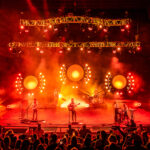
Green Day, Weezer and Fall Out Boy Take on the Stadiums
Green Day, Weezer and Fall Out Boy had rehearsed and were ready to rock in 2020 when everything shut down. This summer, the bands of this Hella Mega Tour emerged from the lockdown to pick up the production plot, load into trucks and hit the road. “We were the first large scale stadium tour out,” says Production Manager Zito. The 21-date trek across the U.S. kicked off July 24—packing Major League Baseball stadiums with audiences of 35,000 and more—ending Sept. 6.
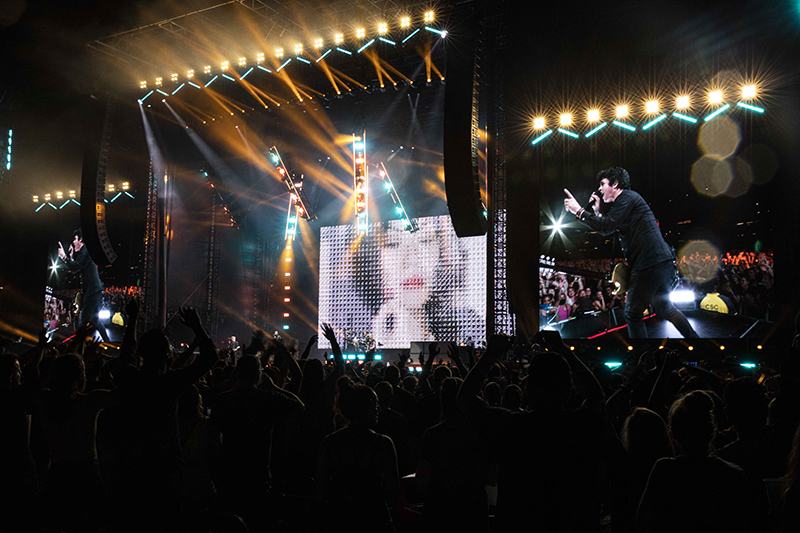
Tight Turnarounds, Leapfrogging Systems
Upstaging provided lighting and video, and Pyrotek punctuated the show with special effects. With such a massive production to handle three bands, it was necessary to leapfrog the two systems. Zito details the traveling show. “We had three trucks of advance production, which were the I-Mag screens and audio delays provided by SES, and spotlights and barricades by Guardian Barrier Services. Additionally, we had a truck of rigging for pre-rigs. This was the only way for us to do the tight timeframes and back to backs on the stadiums. When we came in to the stadiums, we just brought in our 18 trucks of universal production. Having that in advance saved us about five hours on show day.”
G2 Structures provided its K2i stage, which easily adapts to custom configurations. “G2 had seven different systems with all identical stages that leapfrogged ahead of us,” Zito says, adding that depending on each stadium’s configurations, they would use the appropriate system and team for that show.
Labor shortage was an issue. “We were always short on labor and even when the calls were filled, they were a lot of first-time stagehands. It required a lot of patience on our part. Everything was slower, and I don’t think that’s a bad thing,” Zito notes. “I encouraged my team not to focus on the speed but on doing things safely. It was important to teach the locals as we went because they’re going to be the ones filling the calls moving forward and they have to learn. We always loaded in the day before whenever we could. We took advantage of any time we had.”
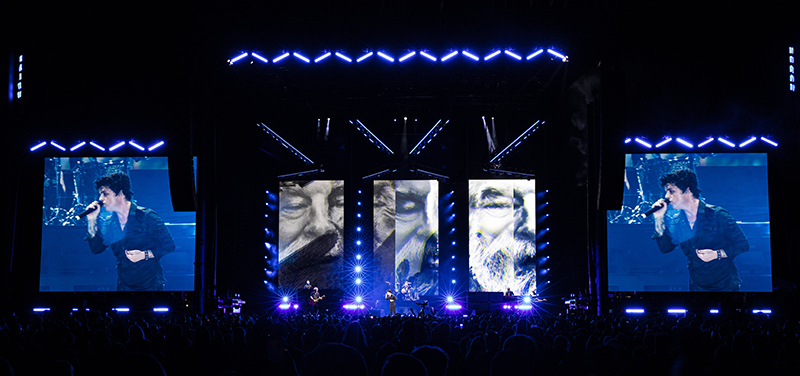
‘It’s about the band and their energy’
Green Day’s show begins before the band hits the stage. Queen’s “Bohemian Rhapsody” and “We Will Rock You” blast through the P.A. with the crowd chanting in full force. By the time lead singer Billy Joe Armstrong takes the stage, he has already captured the crowd and keeps them until the end. There’s no break between songs, it’s constant audience interaction, music and motion.
Production designer Justin Collie of Nimblist had to translate that energy into a set that could move in motion with the band. And then he had to incorporate into that space two more distinct stages for Weezer and Fall Out Boy, with openers The Interrupters. Each band had its own set and lighting designers: LD Brock Hogan for Weezer, and LD Andrew Richter and Tribe Inc. for Fall Out Boy. Collie had to make them all fit in to one space for a singular production. “The device we used to create the distinction for Green Day was not a stage set per se,” Collie says, “instead we relied on a dynamic lighting rig and video screens to create different physical looks. Weezer and Fall Out Boy put their sets into the environment with our lighting rig. When Green Day take the stage, the production evolves dynamically around them.”
Collie counted on Kinesys motion control to create the distinct productions. “Kinesys was the key element to evolve lighting looks throughout the set list—as well as slow, subtle truss moves that can change the dynamic of the visual during songs,” Collie says. Upstaging Tech Paul Mundrick operated the Kinesys Vector Controller, which automated eight diagonal moving Hud truss fingers to change heights and angles. Each finger truss was edged with Upstaging’s Saber LED video strips and loaded with GLP JDC1 strobes and Robe MegaPointe fixtures. The movement was punctuated with pyro from eight Galaxis G-Flame flame units on each finger truss as well.
More movement came from the LED screens that changed locations. Three walls of ROE CB5 Carbon Series outdoor panels—each at 8 panels wide by 7 panels tall—came together behind the band to make up the large central LED video screen, on tracks for movement across the stage. Each stadium supplemented it with in-house I-Mag screens left and right of the stage.
The main lighting rig for all acts included 20 Claypaky Scenius Unico, 86 Robe MegaPointe, 40 Solaris Flare Q+ LR, 20 Solaris Flare, 32 GLP JDC1, 10 Chauvet Strike 1, 32 Chauvet Strike 4, and 4 SGM Q7 LED flood blind strobe. Green Day added an extra 6 Scenius Unico, 46 MegaPointe, 12 Solaris Flare Q+ LR, 28 Solaris Flare, 39 JDC1, 8 Strike 1, 64 Upstaging Saber 1000, and 32 Saber 250. An additional 8 Claypaky Sharpy Wash and 16 GLP X4 Bar20 fixtures were also available for spontaneous placement depending on the venue.
Green Day’s circular drum riser had three steps mounted with a row of JCD1 strobes. The look continued across the stage with two wings of JDC1 under the guitar amps, also pointing toward the audience. Sabers lined the amp line for uplighting.
To keep the smoke and haze levels more evenly distributed at the outdoor shows, Collie positioned six vertical smoke tube columns, uniquely customized, on the stage. “It’s the oldest trick in the book,” he describes: “When I was a lad, you’d burn a hole with a cigarette every three feet of a Visqueen tube and gaffer tape that to your fog machines.” In this case, Reel EFX DF-50 diffusion hazers and High End Systems FQ-100 Performance fog generators were used.
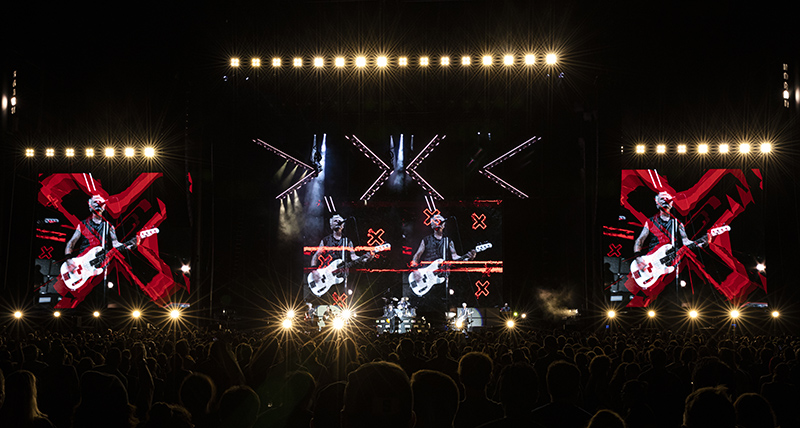
Directing the Light
Tom Horton became lighting director for Green Day starting with the 2016 Revolution Radio Tour, when Ethan Weber was LD. Horton didn’t design or program the lighting for this tour. Instead, he describes himself as “the button pusher,” his role extended to making sure Armstrong’s live interactions with the audience were always in the light.
The tour carried two MA Lighting grandMA2 full size and two grandMA2 light consoles. To keep up his operating chops during the pandemic, Horton practiced cues at home. “Coming into a situation where I had zero input in the design and just had to focus on running the cues, it was weird for me,” he says. But he had an epiphany. It was during Green Day’s gig for a small crowd of 1,800 at Cain’s Ballroom, on their last day of rehearsals this past summer in Tulsa, OK. “I punted the show on a little Avolites console and a handful of lights and punk rocked it, and I realized that I am the live guy. I am an operator. I feed off of it,” he declares. Horton’s skill in following Armstrong’s movements with lighting is much needed for this tour. “I try to match the emotion that’s coming off the stage by lighting the audience reactions so the artist can see them. It’s a return of energy.”
While some lighting fixtures were switched out from the 2020 show that they rehearsed, the cue structure was the same. “Once I had the muscle memory down, it was the same show that we rehearsed a year and a half ago,” Horton notes. He compliments Collie for “the emotion” he designed into it, and the support team with programmer Joe Bay and Loren Barton. “Justin should be very proud of the ship he commanded,” he adds.
While Fall Out Boy had to drop out of two shows because of Covid in their camp, Horton says their crew had no problems because they lived within their bubbles and had no days off, loading in early at the next stadium instead. “Zito did a good job keeping everybody together,” he notes. “Nobody got sick on our crew.”
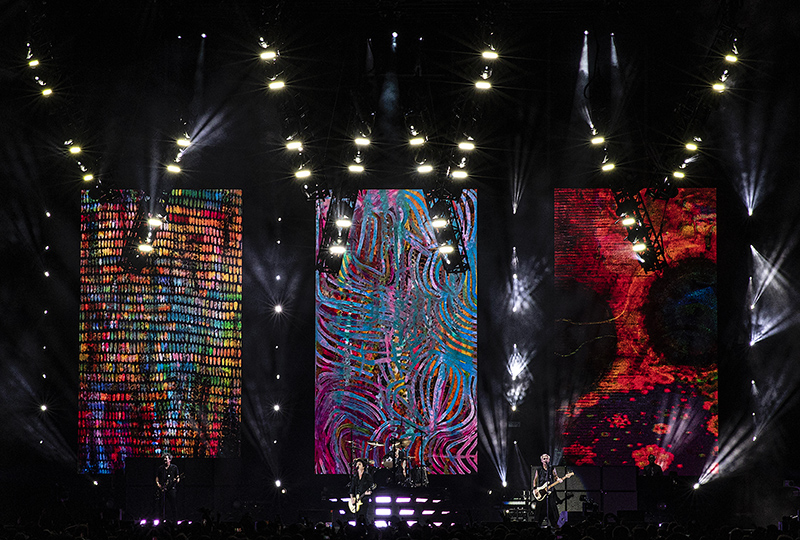
Vis-A-Vis Video
Collie had a big hand in screens direction creating the video content with Justin Nardone at the first rehearsal, with additional content by Mat Fuller of Dark Matter and Linda Strawberry at the second rehearsal. Screens were programmed by Loren Barton, with Joe Bradley running the Green Hippo Hippotizer Hippo V4 Boreal + media server package. “It’s about the band and their energy, their performance,” Collie says. “Our job is to amplify that, so cameras and screens were vital devices in that effort. And of course, finding and using them in interesting, narrative ways to use them while ensuring the audience could see pop stars at all times. For “Jesus of Suburbia”, a nine minute rock opera, we used only white light and live cameras on screens and were still able to amplify the band’s intense energy for the pinnacle of the show.”
To control and deliver the live screen content and unique video backdrops, Video Director Stuart Merser of Vis-A-Vis Video designed and specified Blackmagic Design’s multi-camera video workflow, including multiple BlackCam tracking systems that connected cameras with the band’s’ performances on stage. The camera operators needed to roam off the stage in this show because of the amount of onstage pyro.
Vis-A-Vis designed three systems based on the BlackCam tracking systems. The first was the B60 carrying an URSA Broadcast camera with a Canon CJ15ex4.3B lens on a 60’ track. The 90˚ curved rail ran along the front right-hand side of the stage and continued down a 30’ thrust running out into the crowd. A second B60 system with an URSA Broadcast covered the left side of the front stage edge, while a smaller B20 dolly carried a Micro Studio 4K camera on a tight circular track around Green Day drummer Tré Cool and his kit.
Content for two I-Mag displays stage left and right, and a central video wall was Vision mixed on the ATEM 2 M/E Broadcast Studio 4K with an ATEM 2 M/E Broadcast Panel. “Designed and built to be tour friendly, the system allows us to get in and out of places fast,”
Merser says. The efficiency was necessary because along with the tight turnarounds between dates, the team also had to accommodate changing weather conditions, from 100˚ heat in Texas to rain in the South.
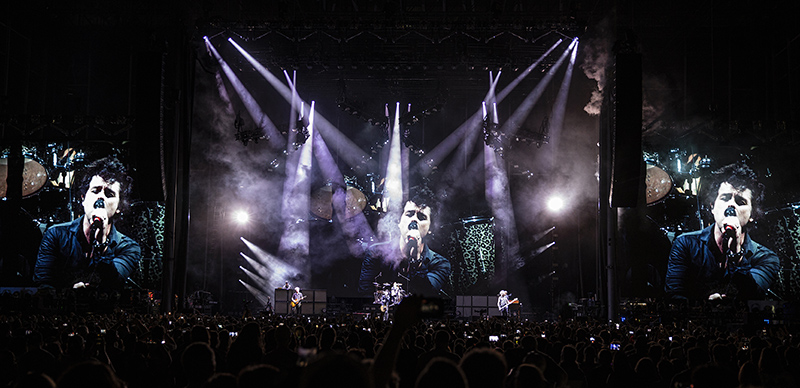
Instruments Bursting into Flames
The Pyrotek Special Effects team triggered pyro, flames, and other effects throughout all three acts. Shooter, Kenneth MacDonald programmed and operated the pyrotechnics/flame systems to create the cues and looks as designed by Collie and Kevin Hughes, the
Pyrotek project manager for Green Day.
A lengthy list of effects enhanced the performance. Taking prominence was the line of large-scale pyro spanning the width of the stage behind Green Day, shooting Comets and Crackle Mines in heights up to 300’, while Silver Waterfalls rained sparks during the song “21 Guns.” MacDonald used the Pyrodigital Firing Systems—from Innovative Pyrotechnik—for pyro. Flame effects included 16 Galaxis Showtechnik’s G-Flame units, eight of which were positioned on the moving finger trusses, controlled with a MA Lighting dot2 XL-F.
While Weezer had a beach ball release and confetti, Fall Out Boy had a large amount of flames, including custom fire effects appearing to burst from the baby grand piano and Pete Wentz’s guitar. “The guitar flame was achieved by making a small flame emitter that he could control independently on his bass,” MacDonald explains.
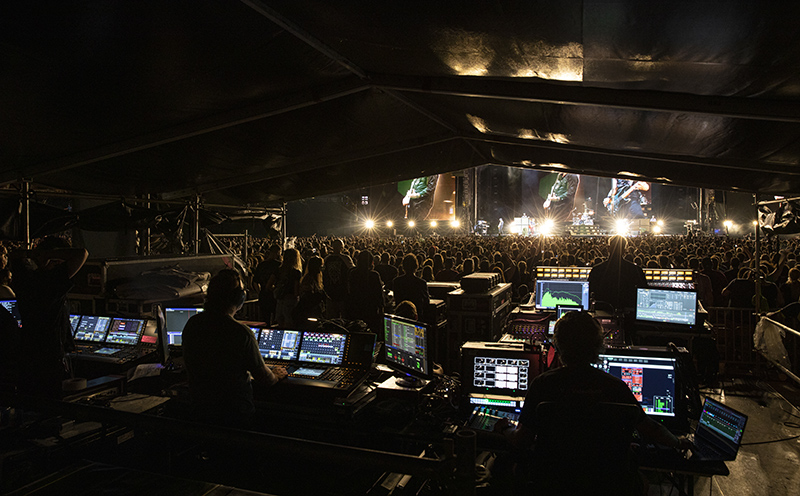
‘When September Ends’
The U.S. tour wrapped on Sept. 6, 2021, and resumes again in Europe in June 2022. In the end, Collie knew his design was right from start—from the reaction of that first show this past summer in Dallas. “It was as if 40,000 people had returned to the church of rock and roll,” he says, ”and every one of them felt the spirit; it was palpable. Green Day is a fantastic band. It was an emotional experience. I’m proud of it as an appropriate design for this band. At the end of that first night, I felt like, despite its many flaws and errors, it was the perfect rock show.”
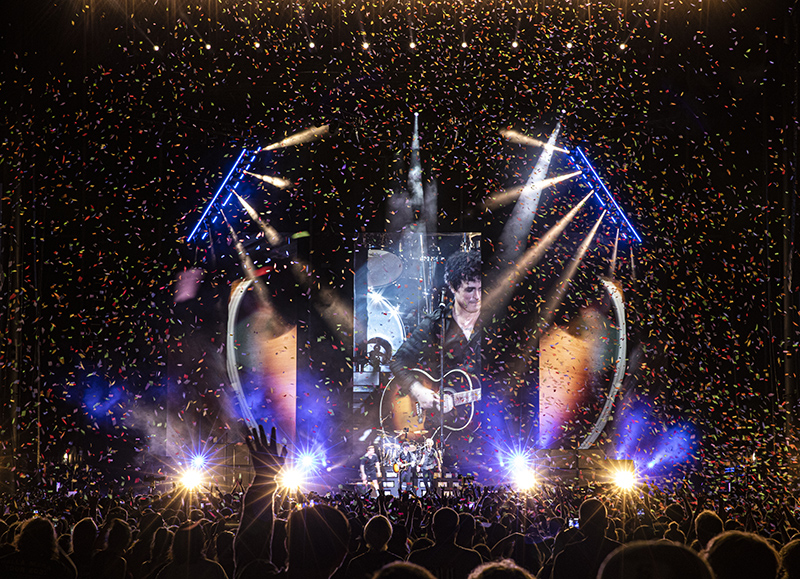
Vendors
Lighting, Video: Upstaging
Staging: G2 Structures
Barricades, Spotlights: Guardian Barrier Services
I-Mag Screens, Audio Delays: SES
Pyro/Special Effects: Pyrotek Special Effects
Crew
Lighting
Production Designer/Lighting Designer: Justin Collie, Nimblist
Programmer: Joe Bay
Screens Programmer: Loren Barton
Lighting Director: Tom Horton
Crew Chief: John “Cheeto” Chiodo
Motion Control: Paul Mundrick
Electricians: Adam Cooper, Rayniel “Ray Ray” Castro, Calvin Mosier, Brendan Langford, Mike Wright, Mike Ponsiglione
Production
Production Manager: Zito
Stage Manager: Ethan Merfy
Production Coordinator: Libby Dostart
Pyro/Special Effects
Shooter: Kenneth MacDonald
Techs: Terry Birdsley, Tim Bruckner, Nate Ceol, Bernie Walker II
Rigging
Lead Rigger: Bill Rengstl
Rigger: Dion Pearce
Rigger/Utilities: Brian “B-Rigs” Benauer
Video
Video Director: Stuart “Stu 1” Merser
EIC: Stuart “Stu 2” Smith
Crew Chief: Kenny Ackerman
Servers: Joe Bradley
LED 2: Oscar Canales Jr
Shader: Marcus Lindsay
LED 3/ VD for Weezer and FOB:
John “Jack” Edinger
Camera Op: Dev Turner
LED: Nick Pishghadamian
Gear
Shared Rig
Lighting
26 Claypaky Scenius Unico
132 Robe MegaPointe
52 Solaris Flare Q+ LR
48 Solaris Flare
75 GLP JDC1
18 Chauvet Strike 1
32 Chauvet Strike 4
4 SGM Q7
Atmosphere
Reel EFX DF-50 diffusion hazers
High End Systems FQ-100 Performance fog generators
6 Smoke Tubes/ Carts
Control
3 MA Lighting grandMA full console
2 MA Lighting grandMA light console
6 MA Lighting grandMA2 NPU
Video
64 Upstaging Saber 1,000 mm
32 Upstaging Saber 500 mm
2 Green Hippo Hippotizer Hippo Boreal+ Media Server Package
168 ROE CB5 full panels – 600 mm x 1,200 mm
in T4 Touring Frames
Kinesys
16 Kinesys Lift Kit Tourkit Hoists 1 Ton
2 Kinesys Vector Controller – main/spare
Remote Followspot System
6 Follow-Me Targets (3 active, 3 backup)
1 Follow-Me Rack (main/spare comp and camera system)
Pyro
Control system: Pyrodigital Firing Systems
Flames
16 Galaxis Showtechnik G-Flame flame units – 8 of these on moving trusses
Control system: MA Lighting dot2 XL-F
